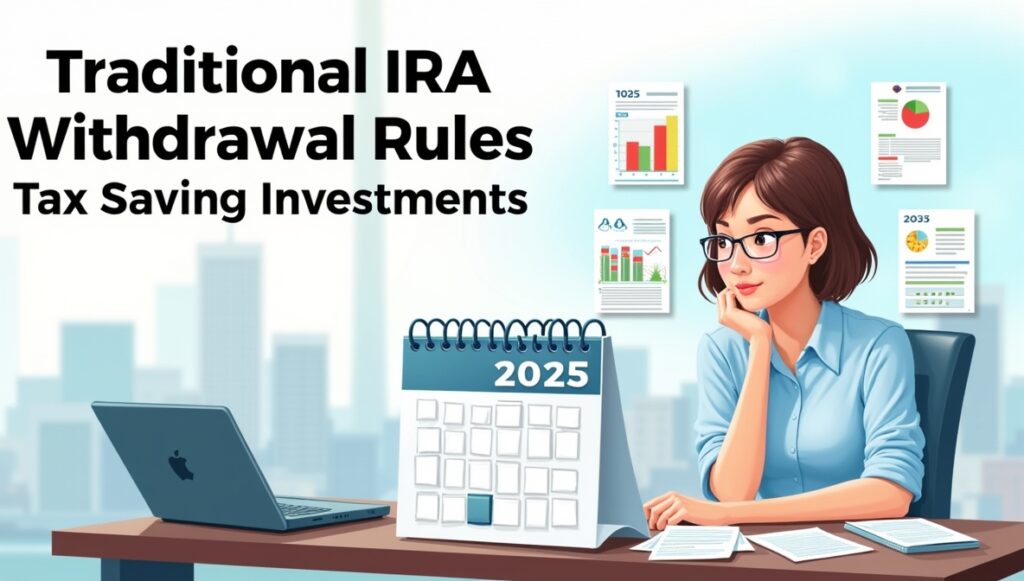
Saving for retirement is one of the smartest choices you can make. A Traditional IRA (Individual Retirement Account) is a powerful way to prepare for the future. But while putting money in is simple, knowing when and how to take it out can be confusing. The Traditional IRA withdrawal rules matter because they can change the way your money is taxed and affect your tax savings with tax saving investments.
This article will guide you through the rules step by step, explain when you can withdraw without big penalties, and show how to keep your tax savings safe. By the end, you’ll understand the key choices you’ll face in 2025 and beyond.
Why Withdrawal Rules Matter
When you put money into a Traditional IRA, you often get a tax break upfront. That means your taxable income goes down, so you pay less in taxes for that year. This is why many people call IRAs a form of tax saving investments.
But here’s the catch: when you take money out later, the IRS wants its share. Withdraw too early, and you could face both taxes and extra penalties. Wait too long, and you may be forced to take money out whether you want to or not. That’s why understanding Traditional IRA withdrawal rules is so important.
At What Age and Under What Rules Can You Withdraw Without Killing Your Tax Savings?
The IRS has set clear guidelines for Traditional IRA withdrawals. Let’s break them down:
1. Withdrawals Before Age 59½
If you withdraw money before you turn 59½, you usually pay two costs:
- Regular income tax on the withdrawal.
- A 10% penalty.
For example, if you take out $10,000 early, you may owe thousands in taxes plus another $1,000 penalty. This can wipe out the benefits of your tax saving investments.
However, there are exceptions. You may avoid the penalty (though not the tax) if you use the money for:
- Qualified education expenses.
- A first-time home purchase (up to $10,000).
- Medical expenses over a certain limit.
- Health insurance while unemployed.
Still, most experts suggest leaving IRA money alone until retirement. Early withdrawals can kill your long-term tax savings with tax saving investments.
2. Withdrawals Between Age 59½ and 73
This is the “sweet spot.” After age 59½, you can withdraw without penalties. You still pay normal income tax, but you don’t face that 10% extra charge.
For many retirees, this is when they start using their IRA money for living costs. If you plan wisely, you can stretch your withdrawals so you only pay the taxes you need to, keeping your tax savings strong.
This period also gives you flexibility. You don’t have to withdraw, but you can. That lets you coordinate with other retirement income sources, like Social Security or pensions.
3. Required Minimum Distributions (RMDs) at Age 73
Once you turn 73 (in 2025), you must begin taking Required Minimum Distributions (RMDs). The IRS doesn’t let you keep money in your IRA forever because they want the tax revenue.
- RMDs are based on your age and account balance.
- If you don’t take the required amount, you face a penalty of 25% of the amount you should have withdrawn.
This makes careful planning essential. The right withdrawal strategy can help you keep more money working for you and maintain your tax savings with tax saving investments.
How Withdrawals Affect Your Taxes
Every dollar you take out of a Traditional IRA counts as taxable income. That means it adds to your yearly income and may push you into a higher tax bracket.
For example:
- If you earn $30,000 from part-time work and withdraw $20,000 from your IRA, your taxable income is $50,000.
- That could raise your tax bill and reduce the overall benefit of your IRA savings.
This is why many retirees work with financial planners. Spreading out withdrawals and coordinating with other income sources can help you avoid paying more taxes than necessary.
In short, the more you understand Traditional IRA withdrawal rules, the more you can protect your tax savings with tax saving investments.
Tax-Smart Strategies for 2025
As rules evolve, 2025 brings both challenges and opportunities. Here are some strategies you can use:
Roth Conversions
You can move money from a Traditional IRA into a Roth IRA. You’ll pay taxes now, but after that, withdrawals are tax-free. This can be smart if you expect to be in a higher tax bracket later.
Timing Withdrawals
Try to withdraw in years when your income is lower. That way, you’ll pay less tax on the money.
Using Exceptions Wisely
If you must withdraw early, check if you qualify for an exception. Even saving just the 10% penalty can help preserve your tax savings.
Pairing with Other Investments
Your IRA is just one part of your plan. Pairing it with other tax saving investments, like 401(k)s or Health Savings Accounts (HSAs), can give you even more control over taxes.
Common Mistakes to Avoid
Even with clear rules, people make costly errors. Here are a few to watch out for:
- Forgetting RMDs – Missing an RMD can cost you a big penalty. Always mark the deadline.
- Withdrawing Too Much – Taking out large sums can push you into a higher tax bracket.
- Relying Only on Exceptions – While helpful, exceptions shouldn’t be your main plan.
- Not Updating Your Strategy – Tax laws change. What worked in 2020 may not be smart in 2025.
Conclusion: Protecting Your Future
The money you put into your Traditional IRA is there to give you security in retirement. But unless you follow the Traditional IRA withdrawal rules, you could lose a big part of your savings to taxes and penalties.
The key is timing. Avoid early withdrawals unless necessary, use the flexibility after 59½, and prepare for RMDs after 73. Combine your IRA with other tax saving investments, and you’ll keep more money in your pocket.
In 2025, staying informed is more important than ever. Retirement rules shift, but by learning how withdrawals impact your taxes, you’ll be ready. With careful planning, you can enjoy the benefits of your hard work and protect your tax savings with tax-saving investments for years to come.


